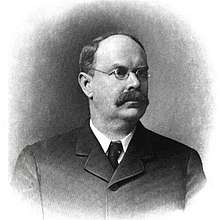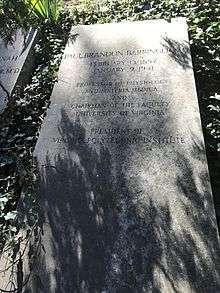Paul Brandon Barringer
| Paul Brandon Barringer | |
|---|---|
 | |
| 6th President of Virginia Polytechnic Institute | |
|
In office September 1, 1907 – July 1, 1913 | |
| Preceded by | John McLaren McBryde |
| Succeeded by | Joseph Dupuy Eggleston |
| Personal details | |
| Born |
February 13, 1857 Concord, North Carolina, U.S. |
| Died |
January 9, 1941 (aged 83) Charlottesville, Virginia, U.S. |
| Children | 10 |
| Alma mater | University of Virginia |
Paul Brandon Barringer, M.D., LL.D., (February 13, 1857 – January 9, 1941) was the sixth president of Virginia Tech, serving from September 1, 1907 through July 1, 1913. He was also chairman of the faculty at the University of Virginia from 1895 through 1903.
Barringer was the son of Confederate General Rufus Barringer and was named after his paternal grandfather, General Paul Barringer (1776-1835), a veteran of the War of 1812. His maternal grandfather Robert Hall Morrison, was a Presbyterian preacher and the first president of Davidson College. Barringer was a nephew of Civil War Generals Stonewall Jackson and Daniel Harvey Hill who married his mother's sisters. Barringer spent some of his childhood in Concord, North Carolina, where, as an eight-year-old, he beat Confederate States of America President Jefferson Davis in a game of chess. Davis had just fled Richmond, Virginia after the surrender of Robert E. Lee.
Barringer received his M.D. degree from the University of Virginia in 1877 and received an M.D. from the University of the City of New York in 1878. He practiced medicine in Dallas, N.C., for three years before going to Europe to study under medical specialists there. From 1881 to 1884 he studied in clinics in London, Paris, and Vienna. On his return from Europe, he settled on a farm near Charlotte, N.C., practicing medicine and farming. He also established and headed a medical preparatory school at Davidson College from 1884 to 1889, when he accepted a position as chair of Physiology at University of Virginia. He served as chairman of the faculty at U.Va. (then equivalent to president) from 1895-1903.
As chairman of the faculty of the University of Virginia, Barringer oversaw major revision of the medical curriculum with the addition of the clinical years of education. He also was the main driving force behind the construction and staffing of the first University of Virginia Hospital. Barringer published a variety of scientific papers dealing with cholera, syphilis, and typhoid fever. He was a recognized authority on venomous reptiles and wrote extensively on the subject. He authored a series of studies of the American Negro between 1896 and 1901.
Barringer rose to national prominence in 1900 after a presentation to the Tri-State Medical Association in Charleston, South Carolina, titled “The American Negro: His Past and Future.” In that essay and other presentations, Barringer addressed what he repeatedly called the "negro problem" facing the South, advocated racial eugenics and suggested that American Negroes had been better off as slaves.[1]The Association voted unanimously to print Barringer's lecture and send copies to all of the medical societies in the South.[2]
From 1903 until he accepted the presidency at V.P.I. in 1907 at age 50, he was professor of therapeutics and pharmacology at U.Va.

During Barringer's administration at V.P.I, the entrance requirements were increased from four to fourteen units; a Farmer's Winter Course was established; summer school was expanded; and Agricultural Hall, now known as Price Hall, was completed. Barringer's tenure as president was marred by disagreements with faculty and alumni as well as the Governor of Virginia. Barringer, a gentleman farmer, was determined to develop the agricultural facet of the College until it achieved parity with the engineering component, which angered some faculty members and alumni. In 1909, the Chairman of the Alumni Association Welfare Committee, Lawrence Priddy, tried unsuccessfully to have Barringer ousted by the Board of Visitors. The Board ordered an investigation and a public hearing was held 25 March 1910, during which Priddy's charges were dismissed as "unwarranted" and "inaccurate." However, this was not the end of Barringer's troubles at V.P.I.
In the fall of 1911, the Board called for another investigation when a former Commandant of Cadets accused Barringer of "countenancing immorality" on campus. An investigation concluded that the charges were "without foundation." Having survived those troubles, Barringer then ran afoul of the Governor, William Hodges Mann, who wanted V.P.I to become involved in agricultural extension work. Barringer disagreed, so Mann stated that he would appoint a Board of Visitors antagonistic to Barringer if he did not resign. On 10 June 1912, Barringer tendered his resignation but the Board asked him to remain in office for another year until a new president could be selected.[3] A year after Barringer's departure from V.P.I. the Smith–Lever Act of 1914 established a system of cooperative extension services, connected to the land-grant universities.
After leaving V.P.I. Barringer returned to Charlottesville where he practiced medicine with the exception of a few years in government service during World War I when he supervised public health measures in American coal mining areas. He died in Charlottesville on Jan. 9, 1941, at age 83.[4]
He was the author of one of the standard works on the history of the University of Virginia: "University of Virginia : its history, influence, equipment and characteristics, with biographical sketches and portraits of founders, benefactors, officers and alumni." (1904)[5]
Honors
Barringer Hall, a residence hall on the Virginia Tech campus that houses 220 male students is named for him.
The Barringer Wing at the University of Virginia Health System, a hospital he was instrumental in founding, is named in honor of Dr. Barringer.
His home in Charlottesville, Virginia, the Barringer Mansion, was listed on the National Register of Historic Places in 1982.[6]
References
- ↑ http://www.collegiatetimes.com/news/when-the-klan-came-to-blacksburg/article_38fc985c-ed72-11e7-b444-bb4b6ea93bb4.html
- ↑ http://twain.lib.virginia.edu/wilson/barrnger.html
- ↑ http://ead.lib.virginia.edu/vivaxtf/view?docId=vt/viblbv00035.xml
- ↑ "Virginia Tech President Paul Brandon Barringer". Spec.lib.vt.edu. Retrieved 2016-11-18.
- ↑ Template:Cite portraits-of-founders-benefactors-officers-and-alumni/oclc/5574443
- ↑ National Park Service (2010-07-09). "National Register Information System". National Register of Historic Places. National Park Service.